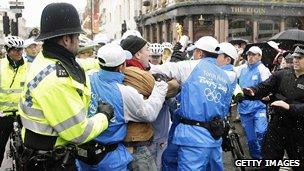London 2012 torch relay to have unarmed security team
- Published

Protests accompanied the 2008 Beijing torch relay in London and other cities
A torch security team of 28 unarmed Metropolitan Police officers will guard the Olympic flame as it journeys around the UK in 2012.
In stark contrast to the protests and security around the Beijing relay, police say they want the focus to be on the torch and its bearer.
A minimum of two officers, without protection equipment, will accompany the runner at all times and the Met will work alongside police from local forces on the day.
Police have appealed to would-be troublemakers not to disrupt the 8,000 torchbearers' "once in a lifetime" opportunity during the 70-day relay.
Met Assistant Commissioner Chris Allison said: "Eight thousand inspiring young people are to carry the torch. Our job is their safety and security. But the focus should be on the torch and torch bearer.
"I sincerely hope people thinking about protesting will say 'this is about these 8,000 people, I'm going to let them have their day'."
"We want the torch bearer to feel reassured they'll be safe so they can concentrate on their moment in a lifetime."
He added that the security threat level for the Games as a whole was still set at "severe" but said police were in a "very good place" with plans.
There was no intelligence surrounding a particular threat to the relay at this stage, he said.
'Self defence techniques'
The torch relay ahead of the 2008 Beijing Games saw widespread protest from pro-democracy campaigners on its trip around the world.
The 2012 relay will travel straight from Greece, where the flame is kindled at Olympia, to the UK, before being carried around most of the British Isles.
The 8,000 mile (12,800km) route - the first details of which were unveiled on Wednesday - starts at Land's End on 19 May 2012.
A total of 49 police will be part of the torch security team, including 8 back-up guards and motorbike-mounted officers, control and planning staff.
They were selected from the capital's borough, detective, airport and other departments and began training in January.
Superintendent Claire Johnston, in charge of the team, said they would use "enhanced self defence" techniques should they need to protect the torchbearer, such as talking to crowds and pushing them back with their bare hands.
Officers in a relay will accompany several torchbearers at a stretch. Each of the 8,000 is due to run an average of 300m.
The Met is working with the local forces who will be in charge of monitoring the route and crowds on the day and each local force will bear the cost of its police operation in its area.
The torch team's cost will be covered by the Met, although additional bills including accommodation and food will come out of the government's 拢600m safety and security budget for the games.
On Thursday, the Police Federation criticised a government cut of 拢125m to that pot as a "recipe for disaster" at a time of heightened security status.
Celebrity stints
Police are still in discussion with London 2012 organisers, Locog, and Irish police and Olympic bodies over the possibility of the torch relay visiting Dublin.
Talks are also ongoing about how to chaperone the 12-24-year-olds who, it is hoped, will make up half of torchbearers.
Police said no special plans were in place for protecting celebrities and high profile figures taking part.
Locog have said the Olympic flame would come within a one-hour journey of 95% of people in the UK.
During the 70-day relay, it will pass through towns and cities including Bristol, Cardiff, Liverpool, Belfast, Glasgow, Aberdeen, Newcastle, Manchester, Sheffield, Nottingham, Oxford, Southampton and Dover.
The torch - which is being created by east London designers Edward Barber and Jay Osgerby and is due to be unveiled in June - will travel for about 12 hours a day, arriving at the Olympic Stadium on 27 July for the lighting of the cauldron at the opening ceremony.
Locog said the route would also include six island visits - to the Isle of Man, Guernsey, Jersey, Shetland, Orkney and the Isle of Lewis.
Further route details would be unveiled in the coming months, the organisers added.
Thousands of people are expected to celebrate along the route, with shows and concerts planned on 66 of the 70 days.
- Published18 May 2011
- Published11 May 2011